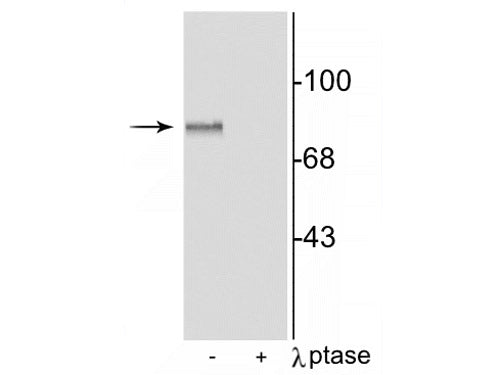Anti-MARCKS (Ser152,156) Antibody
Our Anti-MARCKS (Ser152,156) rabbit polyclonal phosphospecific primary antibody from PhosphoSolution
- SPECIFICATION
- CITATIONS
- PROTOCOLS
- BACKGROUND

| Primary Accession | P30009 |
|---|---|
| Host | Rabbit |
| Clonality | Polyclonal |
| Isotype | IgG |
| Calculated MW | 29795 Da |
| Other Names | 80 kDa protein antibody, 80K L antibody, 80K L protein antibody, 80K-L protein antibody, 80KL antibody, 81 kDa protein, light chain antibody, light chain antibody, MACS antibody, MARCKS antibody, MARCS antibody, MARCS_HUMAN antibody, MGC52672 antibody, myristoylated alanine rich C kinase substrate antibody, Myristoylated alanine rich protein kinase C substrate (MARCKS, 80K L) antibody, Myristoylated alanine rich protein kinase C substrate antibody, Myristoylated alanine-rich C-kinase substrate antibody, Phosphomyristin antibody, PKCSL antibody, PRKCSL antibody, protein kinase C substrate 80 kDa protein light chain antibody, Protein kinase C substrate antibody |
|---|---|
| Target/Specificity | Myristoylated Alanine-Rich C Kinase Substrate (MARCKS) is a major substrate for phosphorylation by protein kinase C (PKC) (Ouimet et al., 1990). The phosphorylation of Ser-152/156 can be used as a measure of PKC activation although these sites are also phosphorylated by PRK1 (Palmer et al., 1996) MARCKS is a member of a family of calmodulin binding proteins and phosphorylation of Ser-152/156 modulates the binding of MARCKS to calmodulin (Verghese et al., 1994) |
| Format | Antigen Affinity Purified from Pooled Serum |
| Storage | Maintain refrigerated at 2-8°C for up to 6 months. For long term storage store at -20°C in small aliquots to prevent freeze-thaw cycles. |
| Precautions | Anti-MARCKS (Ser152,156) Antibody is for research use only and not for use in diagnostic or therapeutic procedures. |
| Shipping | Blue Ice |

Thousands of laboratories across the world have published research that depended on the performance of antibodies from Abcepta to advance their research. Check out links to articles that cite our products in major peer-reviewed journals, organized by research category.
info@abcepta.com, and receive a free "I Love Antibodies" mug.
Provided below are standard protocols that you may find useful for product applications.
Background
Myristoylated Alanine-Rich C Kinase Substrate (MARCKS) is a major substrate for phosphorylation by protein kinase C (PKC) (Ouimet et al., 1990). The phosphorylation of Ser-152/156 can be used as a measure of PKC activation although these sites are also phosphorylated by PRK1 (Palmer et al., 1996) MARCKS is a member of a family of calmodulin binding proteins and phosphorylation of Ser-152/156 modulates the binding of MARCKS to calmodulin (Verghese et al., 1994)
If you have used an Abcepta product and would like to share how it has performed, please click on the "Submit Review" button and provide the requested information. Our staff will examine and post your review and contact you if needed.
If you have any additional inquiries please email technical services at tech@abcepta.com.













 Foundational characteristics of cancer include proliferation, angiogenesis, migration, evasion of apoptosis, and cellular immortality. Find key markers for these cellular processes and antibodies to detect them.
Foundational characteristics of cancer include proliferation, angiogenesis, migration, evasion of apoptosis, and cellular immortality. Find key markers for these cellular processes and antibodies to detect them. The SUMOplot™ Analysis Program predicts and scores sumoylation sites in your protein. SUMOylation is a post-translational modification involved in various cellular processes, such as nuclear-cytosolic transport, transcriptional regulation, apoptosis, protein stability, response to stress, and progression through the cell cycle.
The SUMOplot™ Analysis Program predicts and scores sumoylation sites in your protein. SUMOylation is a post-translational modification involved in various cellular processes, such as nuclear-cytosolic transport, transcriptional regulation, apoptosis, protein stability, response to stress, and progression through the cell cycle. The Autophagy Receptor Motif Plotter predicts and scores autophagy receptor binding sites in your protein. Identifying proteins connected to this pathway is critical to understanding the role of autophagy in physiological as well as pathological processes such as development, differentiation, neurodegenerative diseases, stress, infection, and cancer.
The Autophagy Receptor Motif Plotter predicts and scores autophagy receptor binding sites in your protein. Identifying proteins connected to this pathway is critical to understanding the role of autophagy in physiological as well as pathological processes such as development, differentiation, neurodegenerative diseases, stress, infection, and cancer.


